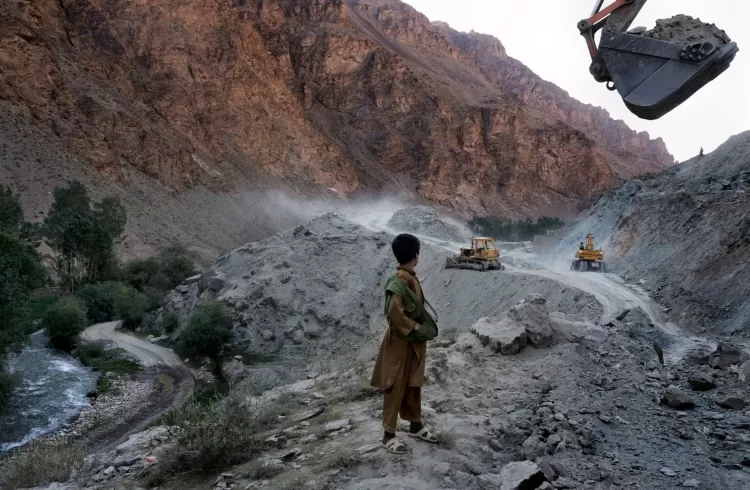Afghanistan's Mining Boom: A $1 Trillion Resource Waiting to Be Tapped
Afghanistan, sitting on an estimated $1 trillion worth of untapped mineral resources, is witnessing a rapid expansion in its mining sector, largely driven by domestic and foreign investment. With the Taliban back in power, the country has signed billions of dollars' worth of mining contracts, especially with China, Iran, and other nations. Despite the growth, the sector faces challenges such as international sanctions, lack of technical expertise, and environmental concerns.

Context & Background:
Afghanistan has long been known to possess vast natural resources, but these valuable assets remained largely untapped due to years of conflict, instability, and a lack of infrastructure. The country’s mineral resources, estimated at over $1 trillion, include precious metals, rare earth minerals, and massive copper and lithium deposits, making Afghanistan a potential powerhouse in the global mining industry.
Since the Taliban's return to power in 2021, the mining sector has been a focal point of its economic strategy, aimed at achieving self-sufficiency and securing crucial revenue streams. This shift has led to an influx of mining contracts, with local companies and foreign investors eager to exploit Afghanistan's vast mineral wealth.
Main Developments:
The Taliban's strategy to tap into Afghanistan's mineral wealth has seen a significant uptick in mining activity, with around 200 mining contracts signed since the takeover, many with local companies. The World Bank reported a 6.9% growth in the mining and quarrying sector during 2023-24, contributing a 2.6% rise in Afghanistan’s industrial sector. This growth is seen as a crucial step toward economic stability, as the country faces challenges from continued international sanctions and a lack of foreign investment.
China, one of Afghanistan’s most significant foreign investors, has emerged as a dominant player in the mining boom. Chinese state-owned enterprise MCC operates the Mes Aynak copper deposit, one of the world's largest copper reserves. The Chinese have also secured additional mining projects in gold and copper. Other nations, such as Iran, Turkey, Uzbekistan, and Qatar, are also eyeing mining opportunities in Afghanistan, contributing to the growth of the sector.
In addition to foreign investments, the mining boom has generated approximately 150,000 jobs since the Taliban’s return to power, providing employment and economic opportunities for many Afghans. However, the mining sector's rapid expansion has been marred by several challenges, including a lack of international expertise and technical capacity, which has hindered some projects from moving forward.
Analysis:
The growth in Afghanistan's mining sector is undoubtedly a positive development for the country's economy, offering new sources of revenue and opportunities for employment. However, the sector is not without its challenges. Afghanistan has suffered from decades of war, leaving a significant gap in the technical expertise and financial capacity necessary to effectively manage its vast natural resources. The country is heavily reliant on foreign investors and technical expertise to bring its mining projects to life.
While foreign companies have the necessary skills and resources to extract, process, and manage Afghanistan's mineral wealth, international sanctions continue to limit broader participation in the sector. These sanctions, coupled with the country’s political instability, make it difficult for international companies to fully invest and participate in Afghanistan's mining boom.
Moreover, the rapid expansion of the mining industry has raised concerns about the sustainability of mining practices. Afghanistan’s lack of infrastructure and regulatory frameworks means that mining activities often occur without sufficient environmental oversight. Experts warn that improper waste management, water contamination, and other environmental risks could have long-term detrimental effects on Afghanistan’s land and water resources.
Environmental concerns aside, the mining industry also faces regulatory risks, as there is currently little in the way of effective government oversight. The Taliban's control of Afghanistan has led to an uncertain regulatory environment, making it difficult for investors to fully assess the risks of operating in the country. With inadequate regulations and weak enforcement mechanisms, it is unclear how Afghanistan will balance the economic benefits of mining with the long-term environmental and social costs.
Regional Focus:
Afghanistan’s growing mining sector is a focal point for neighboring countries and regional investors. China, in particular, has been heavily involved, leveraging its state-owned enterprises to secure major mining deals in Afghanistan. The Mes Aynak copper project is a prime example of this partnership, with Chinese companies eager to tap into Afghanistan’s mineral wealth to meet their own industrial needs. China's interest in Afghanistan’s minerals could also be part of a broader strategy to strengthen its Belt and Road Initiative (BRI) by expanding its influence in Central Asia and the Middle East.
Other regional players, such as Iran, Turkey, and Uzbekistan, are also exploring mining opportunities, seeking to benefit from Afghanistan’s untapped resources. These countries see Afghanistan as a valuable partner in regional economic development, especially given its strategic location and vast mineral wealth.
The potential for cross-border trade in minerals and the possibility of establishing trade routes and mining infrastructure in Afghanistan could lead to greater regional cooperation. However, political instability and security concerns remain a significant hurdle to the realization of these opportunities.
Conclusion:
Afghanistan’s mining sector is undergoing a rapid transformation, driven by both domestic and foreign investments, with the potential to reshape the country’s economic future. The growth of the sector, particularly the influx of Chinese and regional investments, has created jobs and fueled economic activity. However, the sector faces substantial challenges, including a lack of technical expertise, environmental risks, and international sanctions that limit broader foreign participation.
While the mining boom has brought hope for economic self-sufficiency, it also requires careful management to ensure that the benefits are sustainable and equitably distributed. The lack of regulatory oversight and infrastructure raises concerns about the long-term environmental and social impacts of the mining industry. If Afghanistan can address these challenges, its mining sector could become a significant driver of economic growth, providing the country with a much-needed revenue stream in the years to come.
As the sector expands, Afghanistan must strike a delicate balance between harnessing its mineral wealth and ensuring responsible and sustainable mining practices. Only time will tell if the country can successfully navigate these challenges and transform its vast mineral resources into a lasting engine of economic development.
What's Your Reaction?















